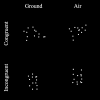Experience modulates gaze behavior and the effectiveness of information pickup to overcome the inversion effect in biological motion perception
- PMID: 39874318
- PMCID: PMC11774361
- DOI: 10.1371/journal.pone.0317290
Experience modulates gaze behavior and the effectiveness of information pickup to overcome the inversion effect in biological motion perception
Abstract
The inversion effect in biological motion suggests that presenting a point-light display (PLD) in an inverted orientation impairs the observer's ability to perceive the movement, likely due to the observer's unfamiliarity with the dynamic characteristics of inverted motion. Vertical dancers (VDs), accustomed to performing and perceiving others to perform dance movements in an inverted orientation while being suspended in the air, offer a unique perspective on this phenomenon. A previous study showed that VDs were more sensitive to the artificial inversion of PLDs depicting dance movements when compared to typical and non-dancers if given sufficient dynamic information. The current study compared the gaze behaviors of non-dancers, typical dancers, and VDs when observing PLDs of upright and inverted dance movements (either on the ground or in the air) to determine if the PLDs were artificially inverted. Behavioral results replicated the previous study, showing that VDs were more sensitive in detecting inverted movements. Eye-tracking data revealed that VDs had longer fixations, primarily directed at the depicted dancer's pelvic area. When performing movements in the air, the depicted dancer was suspended via a harness around their pelvis, providing unique dynamic information that specified the movement's canonical orientation. In contrast, although typical dancers also attended to the pelvic area, their lack of experience with perceiving and performing vertical dance movements limited their ability to interpret the dynamic information effectively. These findings highlight the role of specialized visuomotor experience in enhancing biological motion perception and have implications for training techniques that leverage visual strategies to improve performance in complex or unfamiliar movement contexts.
Copyright: © 2025 Wang et al. This is an open access article distributed under the terms of the Creative Commons Attribution License, which permits unrestricted use, distribution, and reproduction in any medium, provided the original author and source are credited.
Conflict of interest statement
The authors have declared that no competing interests exist.
Figures




References
-
- Morey-Holton ER. The impact of gravity on life. Evolution on planet Earth. Elsevier; 2003. pp. 143–159.
-
- Cutting JE, Kozlowski LT. Recognizing friends by their walk: Gait perception without familiarity cues. Bull Psychon Soc. 1977;9: 353–356. doi: 10.3758/BF03337021 - DOI
MeSH terms
LinkOut - more resources
Full Text Sources
Miscellaneous

